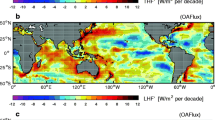Abstract
An analysis of the spatiotemporal variability of advective heat transfer in the atmosphere over the oceans in the Northern Hemisphere has been carried out for 1979–2018 based on reanalysis data. The maximum increase in the advective heat transfer intensity at the beginning of the 21st century is observed in the tropospheric layer of 850–500 hPa at the northern and southern boundaries of the regions in the Pacific Ocean. It is found that the areas of intensive heat outflow and inflow were located near the boundaries of the meridional circulation cells—in the subtropical and subpolar oceanic gyres, respectively. The interannual variability of heat transfer in both oceans is caused, as a rule, by the influence of atmospheric circulation processes. Thus, changes in the transfer characteristics within the identified areas, where an imbalance of heat advection is observed, allow us to conclude about the possible effect of heat transfer from these regions on the occurrence of air-temperature anomalies in the adjacent territories.




Similar content being viewed by others
REFERENCES
Climate Change 2013: The Physical Science Basis. Contribution of Working Group I to the Fifth Assessment Report of the Intergovernmental Panel on Climate Change, Ed. by T. F. Stocker, D. Qin, G.-K. Plattner, (Cambridge Univ. Press, Cambridge, 2013).
A. E. Rozhdestvenskii and G. A. Malyshev, “Estimation of heat sources and sinks in the atmosphere of the Northern Hemisphere,” Meteorol. (Uch. Zap. Ross. Gos. Meteorol. Univ.), No. 45, 142–150 (2016).
M. Yanai and T. Tomita, “Seasonal and interannual variability of atmospheric heat sources and moisture sinks as determined from NCEP–NCAR reanalysis,” J. Clim. 11, 463–482 (1998).
N. K. Kononova, “Features of atmospheric circulation in the Northern Hemisphere in the late 20th and early 21st century and their reflection in the climate,” Slozhnye Sist., No. 2, 11–35 (2014).
K. A. Karimov and R. D. Gainutdinova, “The role of different physical factors in long-period changes of surface temperature,” Tr. Gidrometeorol. Nauchno-Issled. Tsentr. Ross. Fed., No. 366, 121–136 (2017).
S. S. Lappo, S. K. Gulev, and A. E. Rozhdestvenskii, Large-Scale Thermal Interaction in the Ocean–Atmosphere System and Energetically Active Regions of the World Ocean (Gidrometeoizdat, Leningrad, 1990) [in Russian].
W. D. Sellers, “A global climatic model based on energy balance of the Earth–atmosphere system,” J. Appl. Meteorol. 8, 392–400 (1969).
J. E. Martin, Mid-Latitude Atmospheric Dynamics: A First Course (Wiley, New York, 2006).
E. A. Averyanova, A. B. Polonsky, and V. F. Sannikov, “Thermohaline circulation in the North Atlantic and its simulation with a box model,” Izv., Atmos. Ocean. Phys. 53 (3), 359–366 (2017)
H. Stommel, “Thermohaline convection with two stable regimes of flow,” Tellus 13 (2), 224–230 (1961).
A. B. Polonskii, “Global Warming, Large-Scale Processes in the Ocean–Atmosphere System, Thermohaline Catastrophe, and Their Impact on the Climate of the Euro–Atlantic Region (EKOSI-Gidrofizika, Sevastopol, 2008) [In Russian].
S. V. Loginov, E. I. Moraru, and S. V. Kharyutkina, “Relationship of tropospheric circulation cells with the variability of meridional heat flows over Siberia,” Opt. Atmos. Okeana 29 (8), 640–646 (2016).
H. von Storch and F. W. Zwiers, Statistical Analysis in Climate Research (Cambridge University Press, Cambridge, 2003).
T. N. Zadorozhnaya and V. P. Zakusilov, “Influence of the thermal regime in the equatorial zone on the global regime of average monthly air temperature in the Northern Hemisphere,” Geliogeofiz. Issled., 1–7 (2015).
I. I. Mokhov, A. V. Chernokulsky, and A. M. Osipov, “Atmospheric centers of action in the Northern and Southern hemispheres: Features and variability,” Russ. Meteorol. Hydrol. 45 (11), 749–761 (2020).
B. S. Zalogin and A. N. Kosarev, The Seas (Mysl’, Moscow, 1999) [in Russian].
Yu. V. Martynova and V. N. Krupchatnikov, “Peculiarities of the dynamics of the general atmospheric circulation in conditions of the global climate change,” Izv., Atmos. Ocean. Phys. 51 (3), 299–310 (2015).
T. Tamarin and Y. Kaspi, “The poleward shift of storm tracks under global warming: A Lagrangian perspective,” Geophys. Res. Lett. 44, 10666–10674 (2017).
F. Z. Huang, E. Faxiu, and H. Matthew, “Atmospheric circulation associated with anomalous variations in North Pacific wintertime blocking,” Mon. Weather. Rev. 132 (5), 1049–1064 (2004).
I. M. Dima and J. M. Wallace, “On the seasonality of the Hadley cell,” J. Atmos. Sci. 60 (12), 1522–1527 (2003).
A. S. Lubkov, E. N. Voskresenskaya, and O. V. Marchukova, “Temperature anomalies in Europe in the cold time period in relation to ENSO,” Sist. Kontrolya Okruzh. Sredy, No. 36, 73–80 (2019).
E. S. Nesterov, The North Atlantic Oscillation: The Atmosphere and the Ocean (Triada, Moscow, 2013) [in Russian].
G. V. Khen, E. I. Ustinova, and Yu. D. Sorokin, “Main climate indicators for the North Pacific: Nature and history (review of literature),” Izv. Tikhookean. Nauchno-Issled. Inst. Rybn. Khoz. Okeanogr. 197, 166–181 (2019).
Funding
This work was carried out as part of state budget theme no. 121031300154-1, Institute for Monitoring of Climatic and Ecological Systems, Siberian Branch, Russian Academy of Sciences.
Author information
Authors and Affiliations
Corresponding author
Rights and permissions
About this article
Cite this article
Moraru, E.I., Loginov, S.V. & Kharyutkina, E.V. Features of the Spatiotemporal Variability of the Advective Heat Transfer in the Troposphere over the Pacific and Atlantic Oceans in the Northern Hemisphere for 1979–2018. Izv. Atmos. Ocean. Phys. 57, 606–613 (2021). https://doi.org/10.1134/S000143382105011X
Received:
Revised:
Accepted:
Published:
Issue Date:
DOI: https://doi.org/10.1134/S000143382105011X




